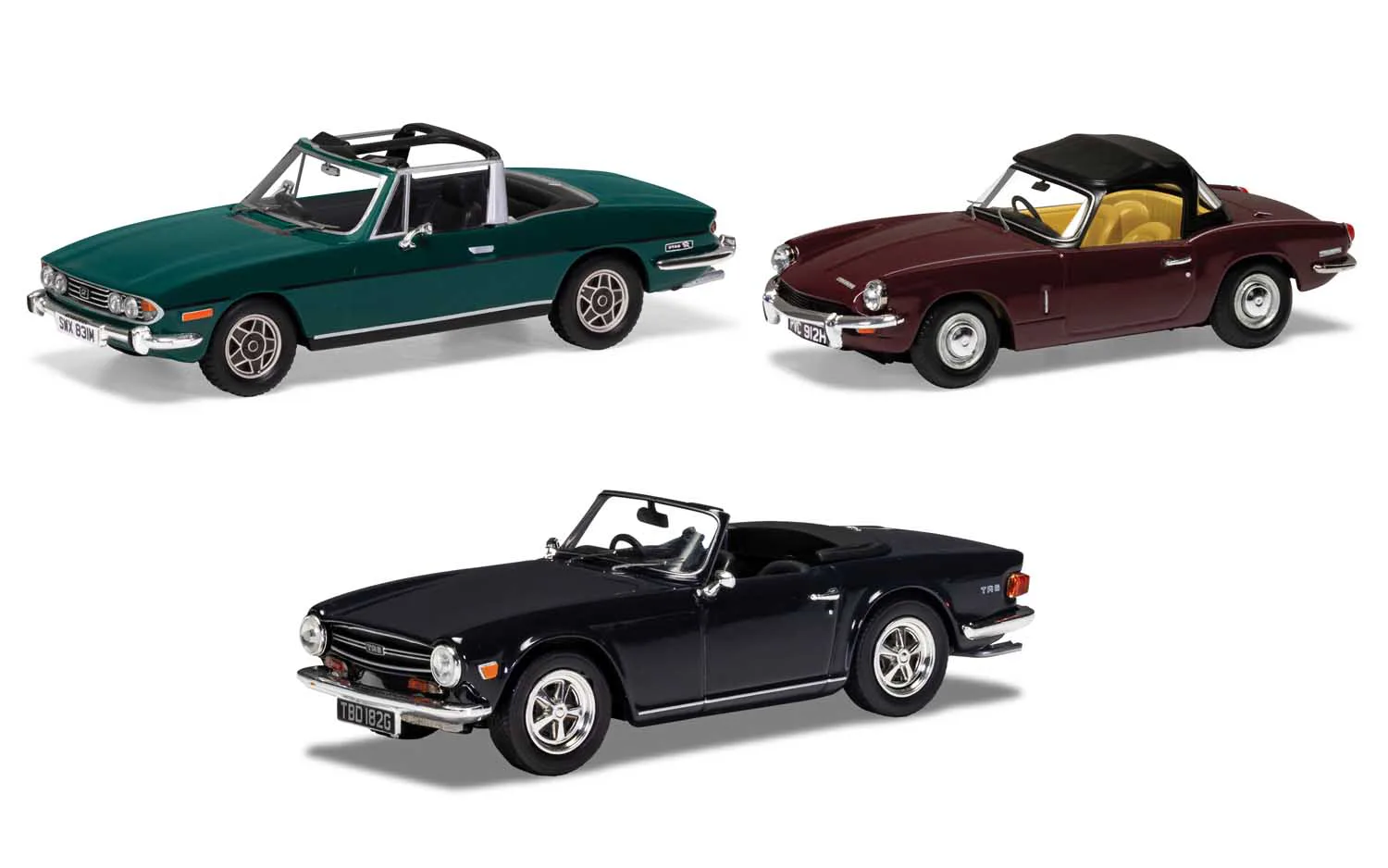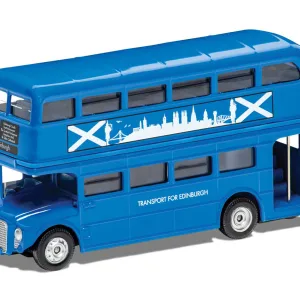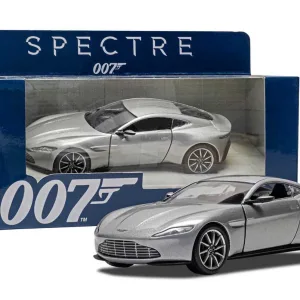Sporting Triumph collection. Stag, Spitfire TR6
Post-war, Triumph had become moribund when, in 1945, their Coventry neighbour Standard purchased them to utilize their pre-war reputation for fine sporting and luxury cars. Standard-Triumph, as they later became, launched the TR2 in 1953 to immediate sales and motorsport success.
Subsequent TR models evolved until the last ‘separate-chassis’ TR6, was produced in 1976. The smaller 1962 Herald-based Spitfire emulated that success until production ceased in 1980, while the beautiful 1970 Stag was a car with the panache and performance needed to succeed in the luxury GT market. These models reflect the three families of sporting car emerging from Triumph’s Canley factory during an era when the company were triumphant on road and track. Triumph Spitfire Mk3. Damson. Brochure Car. The Spitfire modelled was featured in the 1970 model year 8-page colour brochure. In it an attractive young couple are seen in various poses with the car, which is parked in woodland surrounding a lake, or on one page, a racetrack.
The Mk3 had been launched in early 1967 and featured a larger 1296cc engine and a raised front bumper, re-positioned in order to pass US bumper-height regulations. However, for 1970 a range of mainly cosmetic changes were made which, as the brochure exclaimed, included a “black-for-drama grille and windscreen surround”, “flat-spoke steering wheel” and “new wide 4.5J rims”. This brochure was only used for one year as the MkIV was launched in 1971. The Spitfire was based on the Triumph Herald, launched in 1959, which eschewed then fashionable monocoque construction in favour of a separate chassis because industrial circumstances made it almost impossible for Triumph to source a monocoque bodyshell. Their engineers, however, made a virtue of this, developing several different versions, which would have been more difficult to make had it not been constructed on a chassis. With the TR3 proving both popular and profitable, producing a smaller sports car from the Herald’s components to compete with the Austin Healey Sprite was a logical step. The resulting Spitfire styled, like the Herald, by Italian Giovanni Michelotti, debuted to great acclaim in 1962 and ceased production in 1980, by which time 314,342 had been produced.
Engine: 1296cc 4IL OHV; Power: 75bhp@6000rpm Torque: 75lb.ft@4000rpm; 0-60 mph: 14.5 seconds; Maximum speed: 95mph; Kerb Weight: 1652lbs.
The TR6 modelled is one of the first 250 made and so has ‘Rostyle-look’ wheel covers and the desirable 150bhp fuel injected engine. It was built on 27th January 1969 and despatched to Douglas Garage Limited, Northampton, on April 10th and registered there. However, the car’s first owner lived in Greater London and it remained in that area with its first nine owners. The engine was run below the minimum oil level in 1983 and damaged so a USA specification carburettor-fed engine was fitted but the original engine remained with the car. The current owner, Northampton-based Steve Denton, bought it in July 2009 and initially started using it as it was in roadworthy condition. Steve, a trained mechanic, bought the car because the body and paint were good and he knew he could address the car’s mechanical maladies. He rebuilt and refitted the original engine in 2010 and reinstated the Lucas Petrol Injection, adding a modern Bosch pump for reliability. To make the car suitable for modern roads he also fitted an overdrive gearbox; an option when new that wasn’t specified. In 2012 he retrimmed the poor condition interior in the correct shadow blue and fitted a new dashboard. Over the winter of 2017/18 he replaced the often repaired chassis with a new CTM Engineering unit, and fitted polybushes while rebuilding the suspension. The result is a smart reliable TR6 that often features on his eponymous YouTube channel.
Engine: 2498cc IL6 OHV; Power: 150bhp@5000rpm; Torque: 164lb.ft@3000rpm; 0-60mph: 8.2 seconds; Maximum speed: 119mph; Weight: 2473Lbs.
When announced in 1970 the Triumph Stag had everything: a mellifluous 3-litre V8 engine, film star looks by Italian styling legend Michelotti, a beautifully appointed cabin, hard or soft tops and a starring role in a James Bond film. Parent company British Leyland were troubled though, and the Stag entered the market with an engine issue which, although it was relatively easy to solve, led to it acquiring a reputation for overheating in both the UK and its target market, the USA. It was discontinued in 1977 after 25,939 had been produced. It has, however, come of age as a classic, and has both a very high survival rate and a thriving owners club.
The Stag modelled has a manual overdrive gearbox and was built at Triumph’s Canley factory in Coventry on June 1st 1974. It was registered in West Riding, Yorkshire, sho




